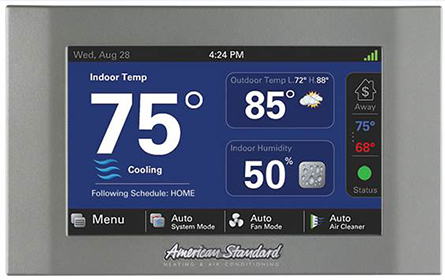Your HVAC system is the biggest consumer of energy in your house. It’s responsible for an average of 40% of your energy usage. Therefore, if you’re looking to lower your energy bills and reduce your carbon footprint, the first place you should probably look is your heating and cooling. Here are five tips to reduce your HVAC system’s energy consumption.
- Seal Ductwork Leaks. Holes in your ductwork can cause energy losses of up to 30%. Cooled or warmed air escapes from your ducts before it can reach your home. This lowers your overall airflow, so it takes longer to heat or cool your home. Check your ductwork for pinhole leaks, tears, and other damage, as well as places where one section of ductwork has come loose from another. You can repair most of this damage with metal tape or mastic sealant. However, despite its name, you should never use duct tape to repair ducts. It loses its adhesiveness over time, so air leaks out from underneath it, without your even knowing.
- Use Ceiling Fans. Ceiling fans use much less energy than your A/C or furnace, and can be used to save energy with no reduction in comfort. In summer, turn your thermostat up a few degrees, while running your ceiling fan. The wind chill factor will make it feel cooler than it actually is. In winter, switch your fan to rotate the opposite direction. As warm air rises, the fan will force it down, allowing your home to come up to temperature more quickly, and saving energy.
- Invest in a Whole Home Humidifier. A whole home humidifier can help your home comfort in a variety of different ways. It keeps your air from getting too wet or too dry, which reduces contaminants in your air, including mold, bacteria, viruses, and more, and improves your overall IAQ. This reduction in contaminants in turn helps your system run more efficiently. In addition, raising your humidity a little bit in winter can make the air feel warmer than it is. You can lower your thermostat and save energy, without sacrificing comfort.
- Get a Smart Thermostat. A smart thermostat helps regulate your home’s temperature more efficiently, by adapting to your family’s schedules. When you’re at home, it heats or cools your home as necessary. Then, while you’re at work and the kids are at school, it switches to an energy saving setting, so you’re not paying to heat or cool an empty house. It can likewise switch to a few degrees cooler at night, which both saves energy and helps you sleep. Some thermostats even come with sensors that can tell when you enter or leave a particular room, and adjust the temperature accordingly.
- Plant a Tree. Trees in your yard can provide great, natural temperature regulation. In the summer, the leaves provide shade, which keeps your home cool. Then in the winter, the tree loses its leaves, allowing the sun to shine through and provide warmth.
These are just a few of the ways you can reduce the burden on your HVAC system throughout the year and save energy. For more energy saving tips, contact us. We can also help you with one of the biggest energy saving methods, which is HVAC maintenance. By keeping your HVAC system properly maintained, you can be sure it runs as efficiently as possible, saving you energy for years to come. Contact us to schedule your maintenance appointment!




